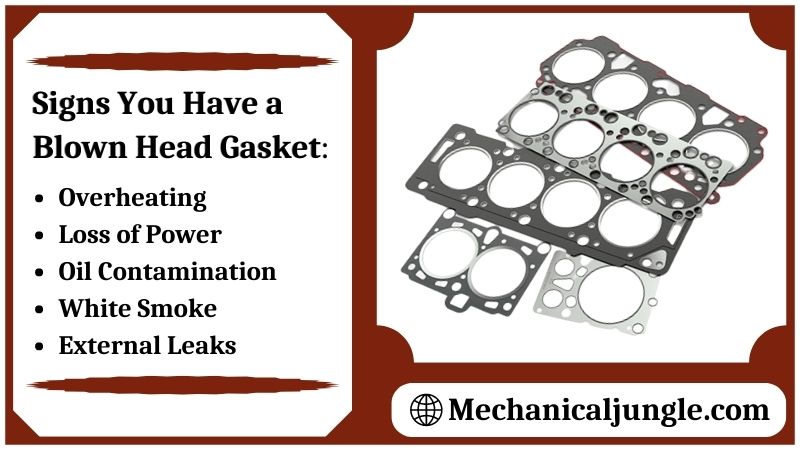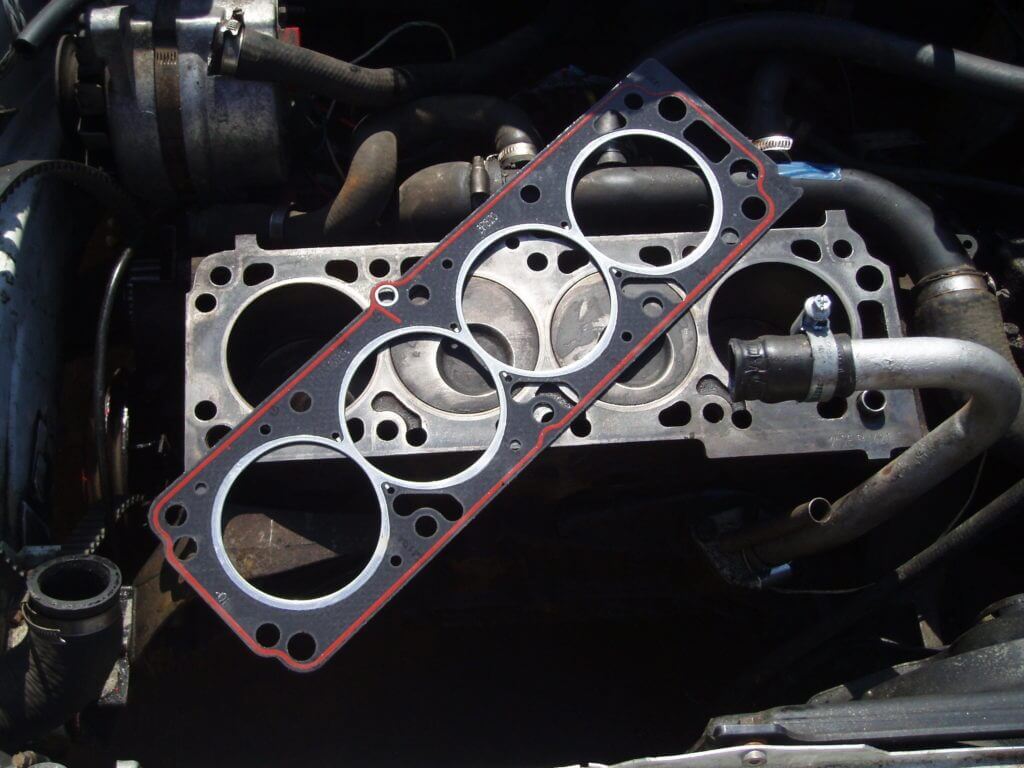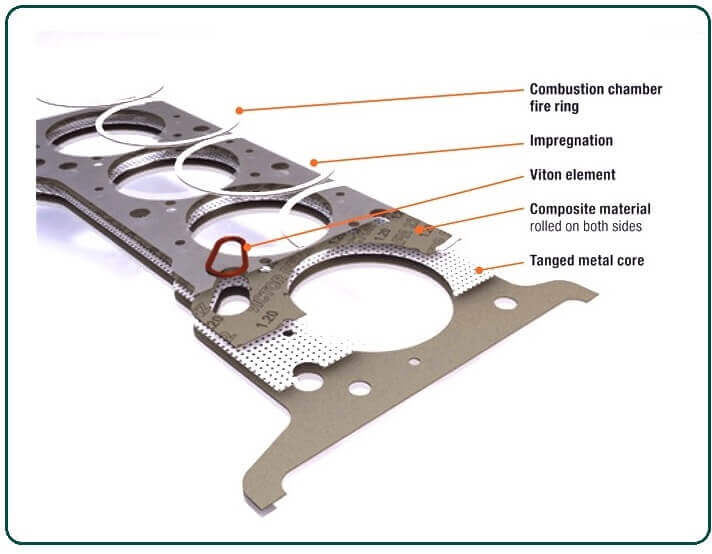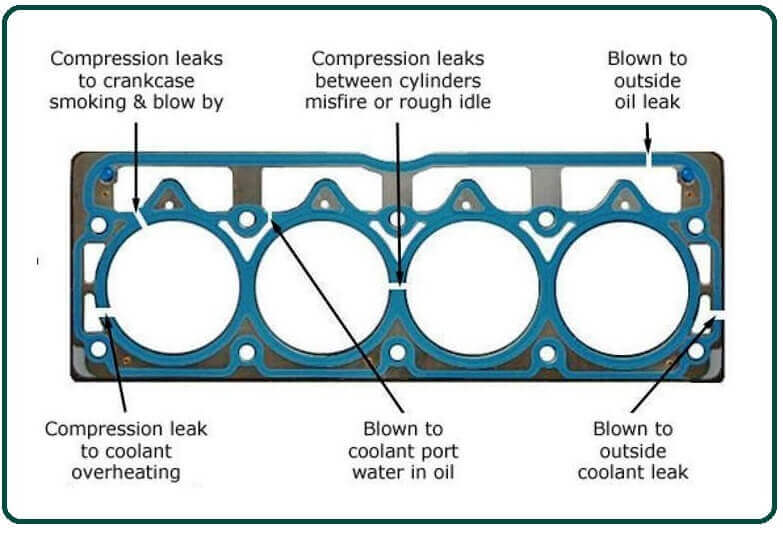Important Point
What Is a Head Gasket?
In addition to sealing the combustion part of the engine to allow oil and coolant to circulate, the head gaskets also seal the combustion chamber in the engine. This allows a vehicle to produce enough power to move forward, as well as preventing harmful gases from exiting the combustion chambers by directing them through the exhausts system.
Head gaskets in modern vehicles consist of several layers of steel material attached to the elastomer, which makes them more durable and longer-lasting. The vehicle produces in the past was equipped with gaskets made by graphite or asbestos.
In comparison, today’s gaskets are superior because they are less prone to leakage and pose no health risks than asbestos-produced gaskets. The head gasket is an important component within a combustible engine. The head gasket ensures that the pressure generated by the ignition of the fuel vapor of the spark plug remains within the combustion chamber.
The combustion chamber contains pistons and requires a high amount of pressure to ensure that the piston continues to fire appropriately. Additionally, oil and coolant have equally important functions, but to perform their functions efficiently, they cannot mix. The head gasket keeps the chambers separate to ensure that there is no cross-contamination of the fluid.
The gasket functions and should be able to maintain sealing and prevent leakage between critical car engine parts when it is being exposed to compression processes. The head gasket of a car comes into contact with many other elements.
Also, Read: What Is Wire Rope? | Types of Wire Rope | Construction of Wire Rope | Different Types of Wire Rope
What Causes a Head Gasket to Blow?
Mosts commons cause of a blown or damaged head gasket is often the result of an engine that has overheated. High engine temperature is usually caused by a lack of coolants within the radiator, usually due to a leak. Some gaskets are likely to weaken quicker than others, depending on their material. For example, aluminum expands rapidly when heated.
Metals with higher thermal expansion rates are more sensitive to heat. Higher temperatures can cause the objects to change shape, which can lead to adverse consequences. The expansion and deformation of the cylinder head as a result of heat weakens its integrity preventing the head gasket from sealing properly.
When the head gasket has blown, it is important that it be addressed immediately. Continuing to operate vehicles with blown gaskets can result in serious and irreparable damage to the engine. Since the gasket is used as a seal, maintaining pressure is the key to engine power.
Once the gasket is blown, it is no longer able to act as a seal and will allow pressure to escape, significantly reducing engine power, one of the few signs of a blown head gasket. Additionally, oil and coolant passages can begin to leak in areas where they shouldn’t.
When coolants enter the combustion chambers, it mixes & dilutes engine oil while also reducing the cooling capacities of the cooling systems, which can cause the engines to overheat.
Also, Read: What Is Cast Iron Material? | Differences Between Cast Iron and Cast Steel | Types of Cast Iron
Why Is a Head Gasket Important?
Before we dive straight into head gasket functionality or important parts, let’s first understand the working and construction of an internal combustion engine. The internal combustion engines are like air pumps. The intake air charge is drawn in, and the exhaust gases are pushed out of it.
The most important things to understand here are that the intake air charge is mixed with the fuel, compressed, & then ignited by the spark plug. These ignitions process produces heat and rapidly expanding gases that force the pistons down and generate the power to turn the motor & eventually move your vehicle.
To accomplish this, a piston in a well-sealed cylinder that can move freely with a system of valves that open & close at just the right time is required with efficiency. These pistons again seal the combustion gases and then releases the exhaust fumes.
Now, in case you wonder about a head gasket and what exactly is a head gasket, here it is. The importance of a gasket can be shown by the fact that it has compression ratios within the combustion chamber of a car.
In addition, the purpose of the forward gasket is also necessary to perform the functions of separating the oil passage and water passage through the engine block and cylinder head. In some cases, when compression in the cylinder creates a perforation, it can create a hole in the head gasket, leading to a blown cylinder head or a blown head gasket.
Functions Performed by Head Gasket:
#1. Handles pressure
The main purpose of a head gasket is, of course, to handle extreme pressures and temperatures, which is a heavy lifting job in itself. For this, it requires extreme maintenance with coolant in the combustion chamber.
Gaskets are responsible for the smooth functioning of the engine.
This is why they are essentially made with the research of the best materials for high performance.
#2. Maintain Temperature
Subject to extreme pressure and Temperature, gaskets are also responsible for oil and coolant requirements in engine parts. Preventing damage from overheating, the gasket seals the coolant channels located between the cylinder head and the engine block.
For any car, its Temperatures is controlled by the thermostats. When engines are cold, no coolant flows out of them. As soon as the engine temperature begins to reach an optimum temperature of about 200 degrees, the thermostat opens.
The thermostat reduces engine wear and the accumulation of harmful deposits leading to the emission of harmful chemicals.
Signs You Have a Blown Head Gasket:
Once a head gasket fails, it can cause all kinds of problems, including:
#1. Overheating
A head gasket failure can occur due to excessive engine overheating resulting from a clogged radiator, coolant leak, faulty fan, etc. However, blown head gaskets will also overheat the engine.
Hot exhaust gases may leak into the cooling system, or the coolant may leak into the cylinder and burn as vapor. In any case, the end result is engine overheating.
If the car is driven during overheating, the alloy cylinder head may also warp, or the steam may damage the catalytic converter, significantly increasing repair costs.
#2. Loss of Power
If the head gasket fails to let the compressed air/fuel out, the compression on that cylinder will decrease. This loss of compression results in rough engine running and a significant reduction in engine performance. These types of failures are usually accompanied by noise such as an exhaust leak.
#3. Oil Contamination
One of the most commons symptoms of head gaskets failure is milk sludge under the oil filler cap or dipstick, sometimes jokingly called a “milkshake.” This is due to the coolant getting into the oil & vice versa.
While these are not conclusive pieces of evidence of head gaskets failure, it is generally a good indicator & a sure sign that your engines need to be taken apart to find the source of contamination. If the oil becomes contaminated with types of antifreeze, the motor bearings quickly wear out with each trip.
Repairs will require at least one engine oil flush, replacement oil filter, and often a complete disassembly of the lower end of the engine to ensures the bearings are not damaged & to remove any contaminates of the oil.
#4. White Smoke
Faulty head gaskets usually result in larges clouds of sweet-smelling white smoke emanating from the exhaust. This is caused by antifreeze that permeates the seal in the cylinder and is converted into steam as part of the combustion process. Fewer commons but still possible is a leak from an oil passageway into the cylinder, which causes blue smoke.
Each of these types of seal failure allows combustion pressure in the cooling system or oil vent system. If the radiator hose suddenly blows out its water outlet or the dipstick doesn’t stay in place, that may be the cause.
#5. External Leaks
If a head gaskets fail between the water or oil passage & the outside of the engine, it can result in simple coolants or oil leaks. This is the least bad version of blown head gaskets, but it’s still serious.
These mays do not manifest themselves as an immediate problem apart from causing a glitch, but letting the coolant level go too far can cause serious engine problems. The second problem is that leaking oil can seep into the hot exhaust and cause pungent smoke and a potential fire.
Also, Read: What Is Cutting Tool? | Materials of Cutting Tool | Classification of Cutting Tools | Types of Cutting Tools
Material of Head Gasket:
The head gasket is known to do the heavy lifting to improve the health of the car, but the question that arises is, what is it designed to maintain such durability? Since the head gasket is exposed to engine oil, coolant, air, and all, it must be of some material that will not react with the oil and coolant.
To maintain all these factors, the head gasket of each vehicle is made unique based on the characteristics of the engine. To meet such goals, millions of pounds are spent on Tata engine parts and Maruti Suzuki engine parts every year.
The material used for most gaskets is stainless steel, but graphite and a range of fibers are also suitable. With the introduction of chemical composites such as silicone, neoprene, and polymeric resins, they have also found common uses.
In addition to the fact that gaskets perform the required functions, they can also be made cheaper than their counterparts due to the mentioned chemical composites.
Also, Read: What Are Cam And Follower? | What Is Cam? | Types of Cam | What Is a Follower? | Types of Follower
Failure of Head Gaskets:
If you suspect a bad head gasket in the car, you should not attempt to drive it, as it may eventually worsen the pre-caused damage. That’s why immediate replacement and servicing are what you should be looking for rather than thrashing around, which is definitely what you need.
Steps to Follow If Head Gasket Fails:
When you have checked the parts of the car and are sure of the fact that a fault has occurred, here are some very important and obvious steps you should take in such situations: Do not try to drive your car in case of such failure. If you think the signs of failure are not strong enough, or it could be another leak problem that you can fix by driving the car to a mechanic, never attempt to do so.
This attempt can be fatal. Get help from a mechanic. He is the best person who notices small signs and can sense them even when you think the problem is not taking over. The repair process can take 4-5 days which is good in the long run. If you are skilled at home mechanic skills and don’t want your car to be pulled over in the garage, you will only need to arrange for a new gasket kit.
Some other requirements may be complied with in order to purchase a new bolt for the cylinder head. Equally important is testing and skimming the cylinder head. Sometimes, as a result of the high temperatures in which it is usually operated, a cylinder head can be repaired by first performing a pressure test to detect any cracks or warping.
Oil, filter, and anti-freeze parts require replacement because they serve as maintenance parts and are prone to damage when the head gasket fails. The head gaskets are one of the most important parts of a car that works harder in the engine to deal with the problems of slow and low, high pressures coupled with high temperatures.
For that reason, failure in the gasket is quite common, and one should not panic when it occurs. When someone quotes a car’s head gasket as blown out, it means the car has a leak. This leak could be an external leak from the engine, which means that the head gasket is allowing cold water to seep out of the engine.
It could also potentially be an internal leak which means that the head gasket is allowing cooling water to be drawn into the cylinder during the intake stroke, and exhaust gases may be allowed inside the cooling passage at the time of the combustion stroke.
Also, Read: What Is a Vehicle? | Parts of Vehicle | Regular Maintenance | Proper Driving
Misunderstood Facts About Head Gasket:
It is also misunderstood as a blower motor problem. But the question is, how can one gasket have so many problem names, and the cost of fixing it is the same as replacing it with the whole engine.
Remarkably some of the best solutions are directed towards building an engine in disassembly or exporting smart parts to achieve that which is equally efficient. Separate the block from the cylinder head and then bolting them together with a seal in the middle can serve as a hack.
This seal acts as a head gasket and is the highest pressure seal for an engine. The head gasket is involved in the job of sealing in the combustion gases during ignition & has to deals with the constantly fluctuating temperatures of the air intake and hot exhausts gases.
The head gasket additionally has to seals the outgoing point of the cooling water, which circulates around the cylinder walls and in turn cools the engine. As discusses earlier, most of the time, it can be hard to notice and tell about the leaking part; however, when you drive with a blown head gasket, cold water, and exhaust gases, those places Entering that shouldn’t cause a serious problem.
It can be noted as the first breakdown point of failure detection point for blown head gasket problems. If the problem is not addressed, temperature fluctuations over time can corrode or corrode the metal. The problem caused by this process will adversely affect the health of the engine; however, you make up your mind to disassemble the engine and then replace the head gasket.
The problem reaches deeper layers over time. Simply replacing it with another seal will not work and will require a replacement. Wear areas & warping can cause a poor seal, even if the ends are then bolted back into the new gasket the same way as previously attempted.
For the whole process, there is a considerable cost that needs to be invested, and manual or self-replacement methods may prove beneficial only for some time but not every time, and in the long run, it is definitely a good idea.
Frequently Asked Questions (FAQ)
What Is a Head Gasket?
In an internal combustion engine, a head gasket provides the seal between the engine block and cylinder head(s). Head gasket (in dark gray with a red border) sitting on top of the inline-four engine block.
What Is the Best Head Gasket Sealer?
- J-B Weld 31319 RTV Silicone Sealant and Adhesive.
- BlueDevil Head Gasket Sealer 38386.
- Bar’s Leaks 1111 Block Seal Permanent Head Gasket Fix.
- K-Seal ST5516 HD Multi-Purpose One-Step Permanent Coolant Leak Repair.
- Bar’s Leaks HG-1 Head Seal Blown Head Gasket Repair.
What Causes a Head Gasket to Blow?
Head gasket failures are usually caused by repeated overheating or continuing to drive after the car has overheated, so the best way to prevent a head gasket failure is to ensure your cooling system is in good condition.
What Is a Blown Head Gasket?
A blown head gasket happens when the seal between the cylinder head and engine block fails. The head gasket sits between these two areas of the engine, sealing the coolant passage, oil return passages, cylinders, and pistons.
Signs You Have a Blown Head Gasket
- Engine Overheating.
- White Smoke From Tailpipe.
- Low Coolant Level.
- Rough Idle/Engine Knock.
- Contaminated Engine Oil.
Material of Head Gasket
While steel is the most common material in which head gaskets are made, other gaskets are made of rubber, silicone, cork, felt, nitrile, fiberglass, and Teflon. Fiberglass is often preferred because of its ability to withstand excessive pressure.
Like this post? Share it with your friends!
Suggested Read –
- Different Kinds of Engines
- Difference Between Orthogonal and Oblique Cutting | Orthogonal Machining
- Parts of Shaper Machine | What Is the Shaper Machine? | Working of Shaper Machine
- What Is a Synchromesh Gearbox? | Principle of Synchromesh Gearbox | Construction of Synchromesh Gearbox | Working of Synchromesh Gearbox
- Working of Constant Mesh Gearbox | What Is a Constant Mesh Gearbox? | Different Gear Ratios in Constant Mesh Gearbox | Construction of Constant Mesh Gearbox
- What Is Magneto Ignition System | How Does an Ignition System Work | How Does a Magneto Work | What Does a Magneto Do | Magneto Ignition System





Leave a Reply